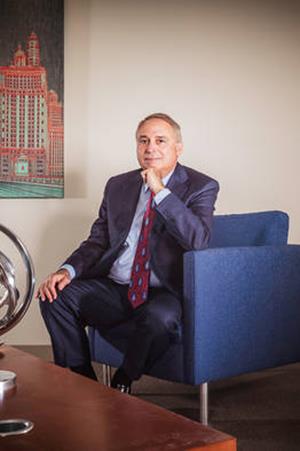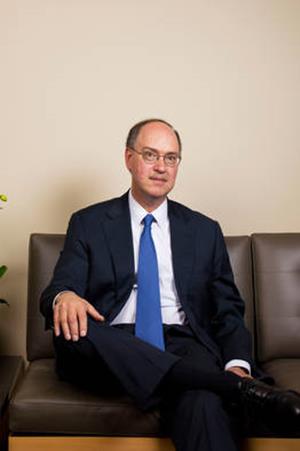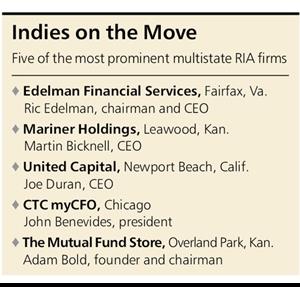|
Advisor
Rankings: Top Independents
Top 100 Independent Financial Advisors
Our annual roster of
America’s best indies -- and what they recommend.
By
Steve Garmhausen
August 22, 2015
Top 100 Independent Financial Advisors for 2015
Top 100 Independent Financial Advisors for 2014
Top 100 Independent Financial Advisors for 2013
The
winds of change are blowing through the ranks of independent
investment advisors. For starters, more advisors than ever are going
independent, drawn by the promise of autonomy and greater latitude in
how they serve clients. At this rate, says research firm Cerulli
Associates, a quarter of all advisors will be indies by 2018, compared
with 20% late last year. At the same time, going independent is more
difficult than ever. The typical registered investment advisor “gets
into the business because he or she wants to be elbow-to-elbow with
clients,” says Martin Bicknell, CEO of Mariner Holdings. “Then they
wake up one day and say, ‘Oh no -- I’m running a business,’ ” with all
its operational and regulatory distractions.
|

Illo: Dave Klug for Barron's
|
The
competing forces are giving rise to a new breed of independent firm --
large, multistate organizations like Bicknell’s, comprising dozens or
even hundreds of advisory practices. The firms give advisors access to
resources and scale that allow them to focus more squarely on the
needs of their clients.
These firms are not a good fit for every independent advisor. Indeed,
relatively few of our Top 100 affiliate with such firms. But the
multistate firms are growing in size and number -- a good development
for clients looking for choice.
Several of the multistates are headed by former Top 100 independent
advisors, including Bicknell’s Mariner and Ric Edelman’s Edelman
Financial Services. Bicknell, like Edelman, had long ranked among
Barron’s top 10 independent advisors, but he voluntarily withdrew
from the rankings as his executive duties became his primary function.
Mariner is still represented in the rankings -- by this year’s No. 29
advisor, Valerie Newell.
Our
ranking of the Top 100 independents is based on assets under
management, the quality of the advisors’ practices, and the revenue
they generate for their firms.
As a
group, the Top 100 is an impressive lot, averaging 27 years of
industry experience and $3.8 billion in client assets under
management. Their client rosters average about 1,100 households, and a
typical account for one of those households is just over $9 million.
When
compared with elite advisors at the large Wall Street firms like
Merrill Lynch and Morgan Stanley, the Top 100 indies serve 27% more
client households and have teams that are more than twice the size.
The average Top 100 indie team consists of 38 people.
We’ve profiled five of the Top 100 in the pages that follow, including
the No. 8 advisor, Greg Miller, who offers some advice that might
serve as a mantra for all indies: “If you want different results,
you’ve got to do something different.”
|

Photo: Bob Stefko
Altair Advisers
Chicago
Assets: $3.8 billion
Rank: 26
|
|
A
former executive with accounting giant Arthur Andersen, Steven
Weinstein borrowed the company’s rallying cry to launch himself into
independence.
“We
had a saying that there are never any problems, only opportunities,”
explains Weinstein, 63, who helped to design and build Andersen’s
investment-advisory and personal financial-planning businesses
nationwide.
In
2002, with Arthur Andersen fatally wounded in the Enron scandal,
Weinstein saw the chance to set up a stand-alone firm that could
control its own destiny. Good call: Chicago-based Altair Advisers now
manages more than $3.8 billion with a team of 43.
At
first, Weinstein seemed destined to follow his father into the field
of law. As a kid, “I didn’t give much thought to being anything other
than a lawyer,” he says.
When
applying to law schools, however, Weinstein learned of a joint law and
M.B.A. program at Northwestern University. Upon graduation from that
program in 1978, he joined his father’s corporate law practice, but he
soon found that he preferred dispensing advice and counsel to arguing
cases. A few years later, Weinstein moved to a boutique advisory firm,
which was subsequently acquired by Andersen.
Weinstein prides himself on identifying new ways to unlock investment
value for clients. Not long ago, the firm’s research confirmed that
the best-performing fund managers over the long term tend to have
three- to five-year periods of substantial underperformance. So,
taking a cue from value stockpickers, the team now looks to buy in on
the cheap to high-quality funds that are temporarily down despite
keeping their management and strategy in place.
“Short-term periods of underperformance by a really good manager can
give you an attractive entry point,” explains Weinstein.
Likewise, understanding that even the best managers cycle through poor
performance can help dissuade investors -- and their advisors -- from
yanking their money prematurely. “The worst mistake a lot of advisors
make is giving up too soon on a great manager,” says Weinstein.
Over
the past year, Altair underweighted two of its most successful
small-cap managers, and overweighted managers “coming out of a bad
cycle.”
The
result of that move: The firm’s small-cap investments are up more than
5% so far this year. The Russell 2000 index of small-cap stocks is up
just 0.6% over the same period.
Weinstein and his firm support a range of charities, including the
Ravinia Festival’s Reach*Teach*Play program, which provides music
education for 18,000 public-school students in the Chicago area.
“There’s a correlation between art and other kinds of achievement,”
explains Weinstein. “To us, this was an opportunity to ensure that
high-quality music education can be available to kids no matter what
their socioeconomic backgrounds.”
|

Photo: Shawn G. Henry for Barron's
Wellesley Investment Advisors
Wellesley, Mass.
Assets: $2.4 billion
Rank: 8 |
|
Modern portfolio theory -- with its emphasis on broad portfolio
diversification -- is considered sacred by most investment advisors.
But Greg Miller wants nothing to do with it. “We don’t really think
modern portfolio theory works,” he says flatly.
Miller, 66, is a leading advocate for convertible bonds --
fixed-income instruments that can be converted to stock at specific
time intervals. Convertibles, he argues, provide appreciation and
principal protection in one neat package.
Thus, while most advisors advocate widely diversified portfolios,
Miller typically invests more than 90% of his company’s assets in
convertible bonds.
Miller originally embraced convertible bonds as a way to change his
family’s investing fortunes. His grandfather made a fortune when he
sold his drugstore chain, but he lost nearly everything in the 1929
crash. A similar fate befell Miller’s father -- who sold his
industrial-cleaning-supply company in the early 1970s, invested the
proceeds in mutual funds, and soon lost most of his money.
Miller started his career as a certified public accountant in 1972.
But like his forebears, he ended up making his fortune as an
entrepreneur. Miller invested in medical companies that were sold for
$10 million in 1986. Determined to protect and expand his windfall,
Miller began learning everything he could about investments. When he
came upon convertible bonds, it was love at first sight.
Along with his 35-person team, Miller follows a disciplined approach
to risk management. He buys notes and bonds only from profitable
corporations with strong balance sheets.
He
holds short- or intermediate-term convertibles -- and only buys longer
issues that include an automatic put feature. The put feature allows
the bondholder to resell to the issuer at certain time intervals. This
allows Miller and company to unload bonds when an issuer’s credit
deteriorates or its stock price falls.
The
power of the put has helped Wellesley to protect principal during bear
markets, and that in turn has allowed Miller’s clients to beat the
market over the long run.
Since 2000, the Thomson Reuters Wellesley Absolute Convertible Bond
index, which Miller and his team developed 15 years ago, has posted
annualized, compounded returns of 8.86%, compared with 5.7% for the
Barclays Aggregate U.S. Bond Index and 4.24% for the S&P 500 Total
Return Index.
Miller senses a desire among investors to replace the conventional
investing playbook, one that he says failed to protect many from
taking a bath in 2001 and 2008.
“If
you want different results,” says Miller, “You’ve got to do something
different.”
|

Photo: Narayan Mahon for Barron's
Steele Capital Management
Dubuque, Iowa
Assets: $1.6 billion
Rank: 42 |
|
Early in his working life, Kevin Timmerman eliminated two vocations
from long-term consideration: lawyer and hog slaughterer.
The
latter got crossed off the list summarily after a post–high school
stint in that gory industry; the former required a little more soul
searching.
Timmerman, now 46, earned his law degree from the University of Iowa
College of Law, but even after graduating in 1994 and passing the bar,
“I realized…that I did not have a passion for practicing law,” says
Timmerman.
Instead, he took the skills he learned in law school -- critical
thinking and tax and estate planning -- to the financial field. He got
his start as a financial planner in Northwestern Mutual’s Dubuque
office, but he soon opened his own practice, a registered
investment-advisory firm.
Like
lawyers, RIAs have a legal duty to act in the best interests of their
clients, and the model allows Timmerman to charge a continuing fee for
advice rather than sales commissions, which can create conflicts of
interest.
Timmerman’s team of 20 manages more than $1.6 billion for 1,125 client
households. He describes his investment approach as “classic asset
allocation” with a long-term view. “We’re not day trading or trying to
time the market,” he says. “We will tweak portfolios over time, but
we’re big believers in the long-term benefits of staying the course.”
Timmerman favors low-cost institutional mutual funds, and eschews
hedge funds and other illiquid investments.
Not
surprisingly, the team’s aggregate asset allocation -- 65% stocks and
35% bonds -- is the same as it was a year ago. Timmerman and the team
did recently increase their weighting to international investments, a
move based on attractive valuations.
Timmerman is not among the many advisors who are trimming their
holdings in bonds. A big chunk of clients’ assets are invested in the
DoubleLine Total Return Bond fund, run by famed bond guru Jeff
Gundlach.
The
fund has returned 1.94% so far this year, compared with 0.59% for the
Barclays U.S. Aggregate Bond Index. “We’ve got a lot of confidence in
him,” Timmerman says of Gundlach.
Timmerman expects the stock market to continue its turbulence
throughout the rest of the year. And he expects continued growth --
“albeit at a slower pace than most of us would like.”
“But
growth is growth,” adds Timmerman, “and growth is a good thing.”
|

Photo: Bob Stefko for Barron's
Gresham Partners
Chicago
Assets: $5.4 billion
Rank: 17 |
|
Edward “Ted” Neild’s approach to investing was forged at Nuveen Asset
Management, where as chief investment officer he oversaw more than $30
billion of fixed-income investments.
In
2005, a desire to serve individual investors more directly led him to
move to Gresham Partners. A decade after going independent, Neild, now
50, has no regrets. He helps to manage about $5.4 billion at Gresham,
which serves 78 well-heeled households.
Neild stewards clients’ money with a healthy skepticism toward
conventional wisdom. Rather than maintaining exposure in every major
asset class, as many advisors do, he cherry-picks only those that
offer significant reward to offset their risk.
In
today’s environment, bonds are in Neild’s doghouse. “The risk-reward
proposition for clients appears to be the worst in several decades,”
he says, citing factors like low yields and tight spreads. “Obviously,
sharply increasing rates makes this investment proposition even
worse.”
Alternatives like private equity, hedge funds, and private placements
are more attractive -- as long as they’re in the hands of the right
manager, he says.
That
brings us to the other key to Gresham’s investing success: finding
jewel-in-the-rough managers. The firm has found that selecting the
right managers accounts for 50% of investment success. These maestros,
however, are typically small, independent outfits and not easy to
unearth.
“Our
investment team traveled half a million miles around the world last
year,” he says. “You have to go where these people are.”
In
today’s environment, the most rewarding place to get manager selection
right is in the alternative-investment realm, Neild says. That’s
because the best alt managers create significantly better performance
than their so-so peers. Among stock- and bond-fund managers, the
difference is more modest, Neild says.
The
Gresham team is particularly keen on managers who specialize in hedge
funds, private equity, and private investments. “Getting to the right
managers makes an enormous difference in outcomes,” he says.
Neild and his firm are focused on supporting education through
Greenhouse Scholars, a program that provides support to help at-risk
college students graduate. Among those who are the first in their
families to attend college, Neild says, the graduation rate is an
abysmal 11%. Among Greenhouse Scholars, it’s 90%.
Why
take up the cause of education? Neild has a simple answer: “The future
prosperity of our country depends on it.”
|

Gregg Segal for Barron's
Westmount Asset Management
Los Angeles
Assets: $2.2 billion
Rank: 52 |
|
As a
federal prosecutor in Los Angeles, Jim Berliner once faced off against
defense lawyer Roger Cossack -- best known today as an ESPN legal
analyst -- in a case involving stolen U.S. Treasury checks. Although
Berliner’s team won the case, Cossack didn’t hold a grudge: Years
later, he was a founding client of Berliner’s fledgling
financial-advisory practice.
As
Berliner, 60, tells it, the shift to working as an independent advisor
wasn’t as dramatic as it may look. “It’s a lot like when I was a
prosecutor,” he says. “You feel like you’re wearing the white hat.”
Berliner, a Los Angeles native, earned a public-policy degree from
Brown University before earning his Juris Doctor from Harvard
University. He served as an editor on the Harvard Law Review,
alongside classmate John Roberts.
In
1990, after nearly a decade as a lawyer, Berliner joined his father in
the still-young field of independent financial advice. Twenty-five
years later, Berliner manages more than $2 billion for 919 households.
He
and his 24-person team combine long- and short-term investments across
traditional and alternative asset classes. A current favorite is Stone
Ridge Funds’ Stone Ridge Reinsurance Risk Premium fund.
The
fund invests alongside reinsurance companies, collecting premiums and
paying out losses for insuring against events like earthquakes and
hurricanes. The investment has zero correlation to the stock or bond
market, Berliner says, and thus may provide stability when traditional
markets are volatile.
In
bonds, the hunt for yield has lately led Berliner to community-bank
debt. With the federal government’s blessing, stronger community banks
have been issuing debt to retire TARP-funded notes, improve their
balance sheets, and raise growth capital. Berliner accesses that debt,
which can yield from 5% to 7%, through the Angel Oak Flexible Income
fund.
When
it comes to stocks, one area of promise is European
residential-mortgage lending. The asset class has been beaten up in
the broad financial selloff, but it’s a solid play, in part because of
comparatively strong underwriting -- Europeans put down as much as 50%
when they buy homes.
Frontier markets, where one can find companies growing at 20% a year
and selling for just nine times earnings, are also worth a look, he
says. “The fundamentals look like larger emerging markets’ did 20
years ago.”
There’s nothing fundamentally wrong with U.S. markets, Berliner says.
His clients maintain a core of large U.S. stocks. But with the market
well picked over, he feels a responsibility to uncover better
opportunities.
“The
conventional approach to investing and asset allocation is sound and
absolutely good, but its not enough,” he says. “Especially at a time
when most assets are fully valued.”
Matt
Barthel contributed to this report.
|







